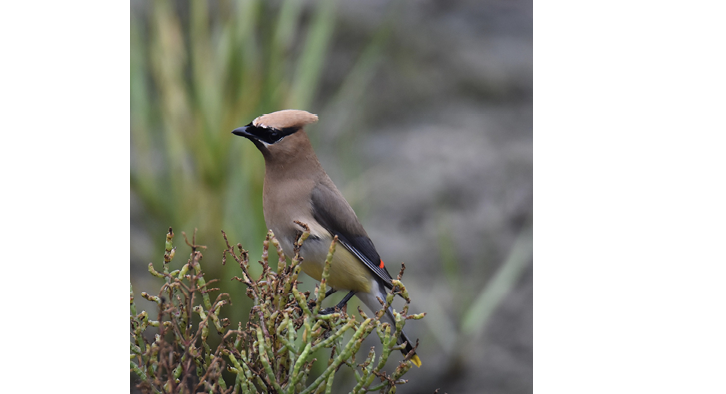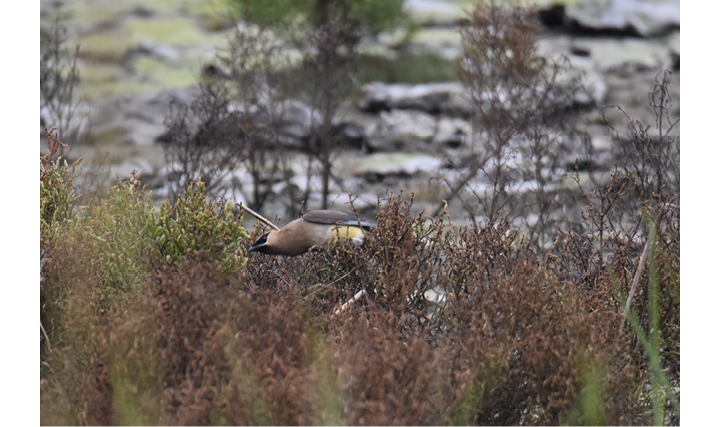Marsha C. Salett

Cedar Waxwing. Photograph by Jaden Thompson.
In late August on Cape Cod when fruits are ripening—beach plum, bayberry, chokecherry, Virginia creeper, and eastern red cedar’s gin-scented berries—it is not unusual to see Cedar Waxwings (Bombycilla cedrorum) at Mass Audubon’s Wellfleet Bay Wildlife Sanctuary at a frequency that belies their nomadic habits. Their diet consists almost entirely of sugary fruits (Witmer et al. 2020) and, in August 2021, the sanctuary had an abundance of food for them.
For several days, I had seen a small flock of waxwings flying around Goose Pond and landing in the oaks that border the pond, near the eastern red cedars that were laden with blue waxy berries this year. The birds did not feed on the cedar berries—a primary source of food in winter—leading me to think that the berries were not quite ripe enough yet. And I did not notice any waxwings feeding on other fruits while I was birding the trails.
On August 29, 2021, around 3:00 pm, my grandson Jaden Thompson and I stopped at Goose Pond to look for shorebirds, although the pond has been reduced to a trickle of water most of the summer. We were delighted to see several Cedar Waxwings fly back and forth across the pond and land in a nearby oak, providing us with good looks of these beautiful frugivores. We continued our walk to the beach and returned to Goose Pond at approximately 5:30 pm.

Cedar Waxwing foraging on Salicornia. Photograph by Jaden Thompson.
Jaden and I found a couple of Cedar Waxwings in the oak tree and several more in the low shrubs at the pond’s edge. Movement drew our gaze to the exposed mudflats, where we saw a waxwing walking. It hopped up onto a patch of Salicornia—commonly called sea pickle for its briny taste—and began to peck at the plant, repeatedly squeezing the succulent stems in its bill but not breaking off any pieces and swallowing them. Soon, three other waxwings joined the first bird on the Salicornia, where they foraged for 15–20 minutes. It reminded me of how we pick Salicornia and chew on it for a burst of saltiness.
Cedar Waxwings take insects and arthropod prey starting in May and tapering off by September, feeding on emerging aerial prey near streams or ponds and gleaning insects from vegetation such as sap-feeding scale insects and spruce budworm (Witmer et al. 2020). None of these insects were present in the saltmarsh vegetation or the little bit of brackish water in Goose Pond; it was the wrong habitat or the wrong time of year. I did not notice any insects on the Salicornia that day, nor did I find any when I zoomed in on the photographs later. Obviously, there is no sugary fruit on Salicornia. What were these waxwings doing?
Witmer et al. (2020) note that Cedar Waxwings are “Reported occasionally to peck at mud of sodium-rich roadside pools; this behavior possibly related to low sodium levels in their predominantly vegetable diet…” I would like to think that after consuming all that sugar, the waxwings simply wanted a taste of salt for a change.
Reference
- Witmer, M. C., D. J. Mountjoy, and L. Elliott. 2020. Cedar Waxwing (Bombycilla cedrorum), version 1.0. In Birds of the World (A. F. Poole, Editor). Cornell Lab of Ornithology, Ithaca, NY, USA. https://doi.org/10.2173/bow.cedwax.01 Accessed October 29, 2021.